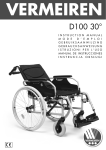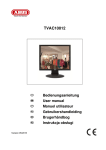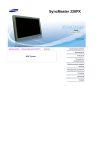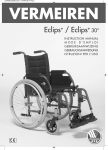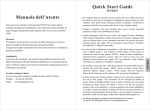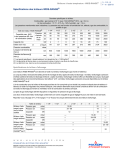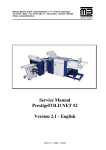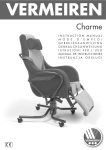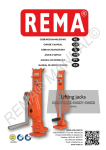Download V300 - 30° - VERMEIREN ČR, s.r.o.
Transcript
VERMEIREN V300 - 30° INSTRUCTION MANUAL M O D E D ’ E M P L O I GEBRUIKSAANWIJZING GEBRAUCHSANWEISUNG ISTRUZIONI PER L'USO MANUAL DE INSTRUCCIONES INSTRUKCJA OBSŁUGI V300 30° 2012-08 V300 30° - Additions to manual V300 1 Product description (refer to manual V300 paragraph 1) 1.1 Technical specifications (add to manual V300 paragraph 1.1) Technical terms below are valid for the wheelchair in standard settings. If other footrest / arm support or other accessories are used, the tabulated values will change. Make Vermeiren Address Vermeirenplein 1/15, B-2920 Kalmthout Type Manual wheelchair Model V300 30° Maximum occupant mass 130 kg Description Min. Max. Overall length with legrest 1040 mm Effective seat width 390 mm 420 mm 440 mm 460 mm 480 mm 500 mm Overall width (depends on the seat width) 590 mm 620 mm 640 mm 660 mm 680 mm 700 mm Folded length 1020 mm Folded width 310 mm Folded height 910 mm Total mass 17,7 kg Mass of heaviest part 10 kg Static stability downhill 10° (in standard configuration) Static stability uphill 2° Static stability sideways 18° (in standard configur ation) Obstacle climbing 60 mm Seat plane angle 0° 10° Effective seat depth 440 mm 520 mm Seat surface height at front edge 440 mm 530 mm 5° 35° Backrest angle Backrest height 400 mm Distance between footrest and seat 420 mm Angle between seat and footrest Distance between armrest and seat 5° 25° 220 mm 240 mm Front location of armrest structure 410 mm Handrim diameter 535 mm Horizontal location of axle (deflection) 1,27 mm Minimum turning radius 1500 mm Diameter Krypton PU Rear wheels 22" Tyre pressure, rear (driving) wheels 200 mm Tyre pressure, steering wheels Storage and use humidity 24" Max. 3.5 bar Diameter Krypton PU steering wheels Storage and use temperature 61,04 mm Max. 2.5 bar + 5 °C + 41 °C 30% 70% We reserve the right to introduce technical changes. Measurement tolerance ± 15 mm / 1,5 kg / ° Table 1: Technical specifications V300 30° Page 1 V300 30° 2012-08 1.2 Drawing (change paragraph 1.3 manual V300) 1 2 3 4 5 6 7 = Push bar = Handles = Lever back inclination = Backrest = Armrests = Arm supports = Driving wheels (rear wheels) 8 = Hand rims 9 = Tip cap 10 = Brakes 11 = Steering wheels (front wheels) 12 = Footrests 13 = Seat 14 = Cross 1.3 Accessories (add to manual V300 paragraph 1.4) The following accessories are available for the V300 30°: • Drum brakes (B74) 1.4 Explanation of symbols (add to manual V300 paragraph 1.6) Not crash-tested 2 Use (refer to manual V300 paragraph 2) 2.1 Backrest inclination (add to manual V300) L WARNING: Risk of tipping over – Be aware that the stability decreases when L L backrest is adjusted backwards. WARNING: Risk of injury – Apply the parking brakes before adjusting the backrest. CAUTION: Chance of pinching – Do not place your fingers, clothes between the adjustment mechanism. With the model V300 30° it is possible to set the b ackrest backwards with a maximum inclination of 30° (4 different positions: steps 10 °). Be sure that the patient sits in the chair when the attendant shall perform the back adjusting and that the wheelchair does not tip over. Page 2 V300 30° 2012-08 1. Pull handle on both sides towards the grab handle to adjust the backrest. 2. The pen Ⓐ comes out the groove of the toothed plate Ⓑ. 3. Pull both back tubes backwards continuously to the desired position (4 different positions: 5° - 15° - 25° - 35°). 4. Check that the pen Ⓐ is well fixed in the groove of the toothed plate Ⓑ. If your wheelchair features drum brakes, the handles are used as brakes. 2.2 Mounting or removing of push bar (add to manual V300) L WARNING: Risk of injury - Make sure that buttons Ⓐ is tightened. L WARNING: Risk of injury - When equipped with the push bar, the push bar shall always be mounted (→ to increase the stability of the back). The mounting of the push bar Ⓑ is done as follows: 1. Mount the push bar Ⓑ with the starknob Ⓐ in the left hand-grip. 2. Swing the push bar Ⓑ to the right. 3. Mount hook Ⓒ over the right hand-grip Ⓓ as shown on the drawing. Use holes adjust the tension of the backrest. To take off the Push bar: 1. Loosen the starknob Ⓐ on the right hand-grip. 2. Remove hook Ⓒ from the right hand-grip Ⓓ. Page 3 or to V300 30° 2012-08 2.3 Transport in the car (add to manual V300 paragraph 2.14) L DANGER: Risk of injury – The wheelchair is not suited for use as a seat in a motor vehicle. Never use your wheelchair as a seat in an automobile or other vehicle. The wheelchair shall be marked with following symbol. 3 Installation and adjustment (refer to manual V300 paragraph 3) 3.1 Manner of delivery (add to manual V300 paragraph 3.2) The Vermeiren V300 30° shall be delivered with: • 1 frame with arm supports, rear and front wheels (standard delivery seat height: 500 mm, seat angle: 5°) • 1 pair footrests • Back adjusting mechanism • Tools • Manual • Accessories 3.2 Adjusting the stability and the maneuverability (add to manual V300 paragraph 3.8) Axle block in most backwards position, anti-tipping is standard available. 4 Maintenance (refer to manual V300 paragraph 4) 4.1 Regular Maintenance (add to manual V300 paragraph 4.1) • 4.2 • Every 8 weeks: inspection and possibly lubricating or adjusting from Backrest inclination system Inspection (add to manual V300 paragraph 4.4) Check the functioning of the backrest inclination (locking, load, deformation, wear caused by loads). Page 4 V300 30° 2012-08 V300 30° - Supplément du manuel du V300 1 Description du produit (se référer au manuel du V300 paragraphe 1 ) 1.1 Caractéristiques techniques (complément du manuel du V300 paragraphe 1.1) Les indications techniques ci-dessous sont valides pour le fauteuil roulant avec ses réglages standard. En cas d'utilisation d'autres repose-pieds/repose-bras ou autres accessoires, les valeurs indiquées sont modifiées. Marque Vermeiren Adresse Vermeirenplein 1/15, B-2920 Kalmthout Type Fauteuil roulant manuel Modèle V300 30° Poids max. du patient 130 kg Description Min. Longueur totale avec repose-jambe Max. 1040 mm Largeur d'assise efficace 390 mm 420 mm 440 mm 460 mm 480 mm 500 mm Largeur totale (en fonction de la largeur d'assise) 590 mm 620 mm 640 mm 660 mm 680 mm 700 mm Longueur plié 1020 mm Largeur plié 310 mm Hauteur plié 910 mm Masse totale 17,7 kg Masse de la partie la plus lourde 10 kg Stabilité statique en descente 10° (en configuratio n standard) Stabilité statique en montée 2° Stabilité statique latérale 18° (en configuration standard) Passage d'obstacle 60 mm Angle du plan d'assise 0° 10° Profondeur d'assise efficace 440 mm 520 mm Hauteur de la surface d'assise sur le bord avant 440 mm 530 mm 5° 35° Angle du dossier Hauteur du dossier 400 mm Distance entre le repose-pied et le siège 420 mm Angle entre le repose-pied et le siège 5° 25° Distance entre l'accoudoir et le siège 220 mm 240 mm Emplacement avant de la structure des accoudoirs 410 mm Diamètre de la main-courante 535 mm Emplacement horizontal de l'essieu (flèche) 1,27 mm Diamètre de braquage minimum 61,04 mm 1500 mm Diamètre des roues arrière Krypton PU 22" Pression des pneus, roues arrière (motrices) 24" Max. 3,5 bars Diamètre des roues directrices Krypton PU 200 mm Pression des pneus, roues directrices Max. 2,5 bars Page 1 V300 30° 2012-08 Température de stockage et d'utilisation Humidité de stockage et d'utilisation + 5 °C + 4 1 °C 30% 70% Nous nous réservons le droit d’apporter des modifications techniques. Tolérance de mesures ± 15 mm / 1,5 kg / °. Tableau 1 : Spécifications techniques V300 30° 1.2 Schéma (remplace le paragraphe 1.3 du manuel du V300) 1 = Barre de poussée 2 = Poignées 3 = Levier d'inclinaison du dossier 4 = Dossier 5 = Manchettes 6 = Repose-bras 7 = Roues motrices (roues arrière) 8 = Mains-courantes 9 = Anti-bascule 10 = Freins 11 = Roues directrices (roues avant) 12 = Repose-pieds 13 = Siége 14 = Traverse 1.3 Accessoires (complément du manuel du V300 paragraphe 1.4) Les accessoires suivants sont disponibles pour le V300 30°: • Freins à tambour (B74) 1.4 Explication des symboles (complément du manuel du V300 paragraphe 1.6) Crash-test: NON 2 Utilisation (se référer au manuel du V300 paragraphe 2) 2.1 Inclinaison du dossier (complément du manuel du V300) L AVERTISSEMENT : Risque de basculement – Soyez conscient que la stabilité diminue lorsque le dossier est basculé vers l'arrière. L AVERTISSEMENT : Risque de blessures – Appliquez les freins de stationnement avant de régler l'inclinaison du dossier. L ATTENTION : Risque de pincement – Ne placez pas vos doigts, les vêtements entre du mécanisme de réglage. Avec le modèle V300 30°, il est possible de bascule r le dossier vers l'arrière avec un angle maximum de 30° (4 positions différentes: palier de 10°). Assurez-vous que le patient est assis dans le fauteuil lorsque l'accompagnateur fait basculer le dossier vers l'arrière et s'assure que le fauteuil roulant ne se renverse. Page 2 V300 30° 2012-08 1. Tirez le levier des deux côtés en direction de pour régler le dossier. la poignée 2. Le plot Ⓐ sort de la rainure de la plaque dentée Ⓑ. 3. Tirez les deux conduits du dossier progressivement vers l'arrière jusqu'à la position désirée (4 positions différentes: 5° 15° - 25° - 35°). 4. Vérifier que le plot Ⓐ soit bien fixé dans la rainure de la plaque dentée Ⓑ. Lorsque le fauteuil roulant est équipé de freins à tambour, les poignées sont utilisées pour freiner. 2.2 Montage ou démontage de la barre de poussée (complément du manuel du V300) L AVERTISSEMENT : Risque de blessures - Assurez-vous que les boutons Ⓐ sont correctement serrés. L AVERTISSEMENT : Risque de lésion - Si le fauteuil roulant dispose d'une barre du poussoir, elle doit toujours être montée ( → afin d'augmenter la stabilité). Le montage de la barre de poussée Ⓑ s'effectue comme suit: 1. Fixez la barre du poussoir Ⓑ avec le bouton à croisillon Ⓐ sur la poignée de gauche. 2. Tournez la barre du poussoir Ⓑ vers la droite. 3. Fixez le crochet Ⓒ sur la poignée de droite Ⓓ comme indiqué sur le dessin. Utiliser les ou pour ajuster la tension du dossier. trous Pour supprimer la barre du poussoir : 1. Détachez la vis Ⓐ au niveau de la poignée droite. 2. Enlevez le crochet Ⓒ de la poignée droite Ⓓ. Page 3 V300 30° 2012-08 2.3 Transport en voiture (complément du manuel du V300 paragraphe 2.14) L DANGER : Risque de lésion - Le fauteuil ne convient pas pour être utilisé comme un siège dans un véhicule motorisé. N'utilisez jamais le fauteuil roulant comme un siège dans une voiture ou dans un autre véhicule. Le fauteuil roulant est marqué avec le symbole suivant : 3 Installation et réglage (se référer au manuel du V300 paragraphe 3) 3.1 Mode de livraison (complément du manuel du V300 paragraphe 3.2) Le Vermeiren V300 30° doit être livré avec : • 1 châssis avec repose-bras, roues avant et arrière (fourniture standard hauteur du siège : 500 mm, angle du siège : 5°) • 1 paire de repose-pieds • Système de réglage du dossier • Outils • Mode d’emploi • Accessoires 3.2 Réglage de la stabilité et de la manoeuvrabilité (complément du manuel du V300 paragraphe 3.8) Bloc d'essieu en arrière position, roues anti-bascule sont livrable standardément. 4 Maintenance (se référer au manuel du V300 paragraphe 4) 4.1 Maintenance régulière (complément du manuel du V300 paragraphe 4.1) • 4.2 • Toutes les 8 semaines : inspection et éventuellement lubrification et réglage de Système de réglage du dossier Inspection (complément du manuel du V300 paragraphe 4.4) Contrôlez le fonctionnement des inclinaison du dossier (verrouillage, charge, déformation, usure liée aux charges). Page 4 V300 30° 2012-08 V300 30° - Aanvullingen op de handleiding V300 1 Productomschrijving (Verwijs naar handleiding V300 paragraaf 1) 1.1 Technische specificaties (toevoegen aan handleiding V300 paragraaf 1.1) Onderstaande technische gegevens zijn geldig voor de rolstoel in standaard instellingen. Wanneer er andere voetsteunen / armsteunen of andere accessoires worden gebruikt, worden de opgegeven waarden gewijzigd. Merk Vermeiren Adres Vermeirenplein 1/15, B-2920 Kalmthout Type Manuele rolstoel Model V300 30° Maximale massa gebruiker 130 kg Beschrijving Min. Totale lengte inclusief voetsteun Max. 1040 mm Effectieve zitbreedte 390 mm 420 mm 440 mm 460 mm 480 mm 500 mm Totale breedte (afhankelijk van de zitbreedte) 590 mm 620 mm 640 mm 660 mm 680 mm 700 mm Lengte dichtgevouwen 1020 mm Breedte dichtgevouwen 310 mm Hoogte dichtgevouwen 910 mm Totaal gewicht 17,7 kg Gewicht zwaartste onderdeel 10 kg Statische stabiliteit bergaf 10° (in standaard configuratie) Statische stabiliteit bergop 2° Statische stabiliteit zijwaarts 18° (in standaard c onfiguratie) Maximum hoogte hindernis 60 mm Zithoek 0° 10° Effectieve zitdiepte 440 mm 520 mm Zithoogte aan voorzijde 440 mm 530 mm 5° 35° Rughoek Rughoogte 400 mm Afstand tussen zit en voetsteun 420 mm Hoek tussen zit en voetsteun Afstand tussen armsteun en zit 5° 25° 220 mm 240 mm Afstand voorzijde armsteun 410 mm Diameter aandrijfhoepel 535 mm Horizontale afstand van de as (uitwijking) 1,27 mm Minimale draaicirkel 61,04 mm 1500 mm Diameter Krypton PU achterwielen 22" Bandendruk, achter (aandrijf)wielen 24" Max. 3,5 bar Diameter Krypton PU stuurwielen 200 mm Bandendruk, stuurwielen Max. 2,5 bar Opslag en gebruikstemperatuur Opslag en gebruiksluchtvochtigheid + 5 °C + 41 °C 30% 70% We behouden ons het recht voor om technische wijzigingen te introduceren. Meettolerantie ± 15 mm / 1,5 kg / ° Tabel 1: Technische specificaties V300 30° Pagina 1 V300 30° 2012-08 1.2 Onderdelen (Verander paragraaf 1.3 in handleiding V300) 1 = Duwstang 2 = Handvaten 3 = Hendel voor ruginclinatie 4 = Rug 5 = Armleggers 6 = Armsteunen 7 = Aandrijfwielen (achterwielen) 8 = Grijphoepels 9 = Trapdop 10 = Remmen 11 = Stuurwielen (voorwielen) 12 = Voetsteunen 13 = Zit 14 = Kruis 1.3 Accessoires (toevoegen aan handleiding V300 paragraaf 1.4) Volgende accessoires zijn beschikbaar voor de V300 30°: • Trommelremmen (B74) 1.4 Verklaring van desymbolen (toevoegen aan handleiding V300 paragraaf 1.6) Niet gecrashtest 2 Gebruik (Verwijs naar handleiding V300 paragraaf 2) 2.1 Inclinatie van de rug (toevoegen aan handleiding V300) L WAARSCHUWING: Kantelgevaar – Denk eraan dat de stabiliteit toeneemt als de rug naar achteren wordt gekanteld. L WAARSCHUWING: Gevaar voor letsel – Zorg ervoor dat de remmen van de L rolstoel aangetrokken zijn voordat U de rug inclinatie versteld. VOORZICHTIG: Kans op beknelling - Plaats Uw vingers, kledij niet tussen het verstelmechanisme. Met het model V300 30° is het mogelijk om de rug, m et een maximale inclinatie van 30° (4 verschillende posities: stappen van 10°), naar acht eren te kantelen. Zorg ervoor dat de patiënt in de rolstoel zit als de begeleider de rug inclinatie versteld en dat de rolstoel niet achter over kantelt. Pagina 2 V300 30° 2012-08 1. Trek de hendel aan beide kanten naar de handgreep om de rughoek te verstellen. 2. De pen Ⓐ komt uit de groef van de plaat met uitstulpingen Ⓑ. 3. Trek beide rugbuizen geleidelijk aan naar achteren tot de gewenste positie (4 verschillende posities: 5° - 15° - 25° - 35°). 4. Controleer dat de pen Ⓐ terug goed is gepositioneerd in de groef van de plaat Ⓑ. Als de rolstoel trommelremmen heeft; dan worden als remmen gebruikt. de hendels 2.2 Plaatsen of verwijderen van de duwstang (toevoegen aan handleiding V300) L WAARSCHUWING: Kans op letsel - Zorg ervoor dat de knoppen Ⓐ terug goed zijn vastgemaakt. L WAARSCHUWING: Gevaar voor letsel - Als de rolstoel over een duwstang beschikt, dient deze altijd te worden gemonteerd ( → ter verhoging van de stabiliteit). Om de duwstang te monteren Ⓑ gaat U als volgt te werk: 1. Monteer de duwstang Ⓑ in de linkse handgreep met behulp van de sterknop Ⓐ . 2. Draai de duwstang Ⓑ naar de rechterkant. 3. Monteer de haak Ⓒ over de rechte handgreep Ⓓ zoals aangegeven in de figuur. Gebruik of om de spanning van de rug in te stellen. de boringen Om de duwstang te verwijderen: 1. Maak de sterknop Ⓐ aan de rechtse handgreep los. 2. Verwijder de haak Ⓒ van de rechtse handgreep Ⓓ. Pagina 3 V300 30° 2012-08 2.3 Transport in de auto (toevoegen aan handleiding V300 paragraaf 2.14) L GEVAAR: Gevaar voor letsel – De rolstoel is niet geschikt om te gebruiken als een zit in een motorvoertuig. Gebruik de rolstoel nooit als een zit in een auto of ander voertuig. De rolstoel wordt gemarkeerd met het volgende symbool: 3 Installatie en instellingen (Verwijs naar handleiding V300 paragraaf 3) 3.1 Leveringsomvang (toevoegen aan handleiding V300 paragraaf 3.2) De Vermeiren V300 30° wordt geleverd met: • 1 frame gemonteerd met armsteunen, achter- en voorwielen (standaard levering zithoogte: 500 mm, zithoek: 5°) • 1 paar voetsteunen • Rugverstellingsmechanisme • Gereedschap • Handleiding • Accessoires 3.2 Instellen van de stabiliteit en manouvreerbaarheid (toevoegen aan handleiding V300 paragraaf 3.8) Asblok in de meest achterwaartse positie, anti-tipping is standaard aanwezig. 4 Onderhoud (Verwijs naar handleiding V300 paragraaf 4) 4.1 Periodiek onderhoud (toevoegen aan handleiding V300 paragraaf 4.1) • 4.2 • Om de 8 weken: nakijken en eventueel smeren of afstellen van Systeem voor ruginclinatie Inspectie (toevoegen aan handleiding V300 paragraaf 4.4) Controle op de werking van de ruginclinatie (vergrendeling, belasting, vervorming, slijtage door belasting) Pagina 4 V300 30° 2012-08 V300 30° - Ergänzungen zur Gebrauchsanweisung V300 1 Produktbeschreibung (Bezug zur Gebrauchsanweisung V300, Kapitel 1) 1.1 Technische Daten (Ergänzung zur Gebrauchsanweisung V300, Kapitel 1.1) Die im Folgenden aufgeführten technischen Daten gelten für einen Rollstuhl in der Standardkonfiguration. Wurden eine Fußplatte und/oder eine Armauflage oder anderes Zubehör montiert, ändern sich die in der Tabelle aufgeführten Werte. Hersteller Vermeiren Adresse Vermeirenplein 1/15, B-2920 Kalmthout Typ Manueller Rollstuhl Modell V300 30° Max. zulässiges Gewicht des Rollstuhlfahrers 130 kg Beschreibung Min. Gesamtlänge mit Beinstütze Max. 1040 mm Effektive Sitzbreite 390 mm 420 mm 440 mm 460 mm 480 mm 500 mm Gesamtbreite (abhängig von der Sitzbreite) 590 mm 620 mm 640 mm 660 mm 680 mm 700 mm Länge zusammengeklappt 1020 mm Breite zusammengeklappt 310 mm Höhe zusammengeklappt 910 mm Gesamtgewicht 17,7 kg Gewicht des schwersten Teils 10 kg Statische Stabilität, bergab 10° (in der Standardko nfiguration) Statische Stabilität, bergauf 2° Statische Stabilität, seitwärts 18° (in der Standar dkonfiguration) Überfahren von Hindernissen 60 mm Winkel der Sitzfläche 0° 10° Effektive Sitztiefe 440 mm 520 mm Höhe der Sitzoberfläche an der Vorderkante 440 mm 530 mm 5° 35° Rückenlehnenwinkel Rückenlehnenhöhe 400 mm Abstand zwischen Fußplatte und Sitz 420 mm Winkel zwischen Sitz und Fußplatte Abstand zwischen Armauflage und Sitz 5° 25° 220 mm 240 mm Vordere Lage der Armauflage 410 mm Greifreifendurchmesser 535 mm Horizontale Lage der Achse (Deflektion) 1,27 mm Kleinster Wenderadius 61,04 mm 1500 mm Durchmesser der Krypton PU-Hinterräder 22" Reifendruck, Hinterräder (Antriebsräder) 24" max. 3,5 bar Durchmesser der Krypton PU-Lenkräder 200 mm Reifendruck, Lenkräder max. 2,5 bar Temperaturbereich für Lagerung und Nutzung 5 °C Seite 1 +41 °C V300 30° 2012-08 Luftfeuchtigkeitsbereich für Lagerung und Nutzung 30% 70% Technische Änderungen vorbehalten. Messtoleranzen ± 15 mm / 1,5 kg / ° Tabelle 1: Technische Daten V300 30° 1.2 Komponenten (Änderung Kapitel 1.3, Gebrauchsanweisung V300 ) 1 = Schiebestange 2 = Handgriffe 3 = Hebel für Rückenneigung 4 = Rückenlehne 5 = Armauflagen 6 = Armauflagenträger 7 = Antriebsräder (Hinterräder) 8 = Greifreifen 9 = Kipphilfe 10 = Bremsen 11 = Lenkräder (Vorderräder) 12 = Fußstützen 13 = Sitz 14 = Schere 1.3 Zubehör (Ergänzung zur Gebrauchsanweisung V300, Kapitel 1.4) Folgendes Zubehör ist erhältlich für die Modelle V300 30°: • Trommelbremsen (B74) 1.4 Positionstypenschild (Ergänzung zur Gebrauchsanweisung V300, Kapitel 1.6) Nicht durch Crashtest geprüft 2 Verwendung (Bezug zur Gebrauchsanweisung V300, Kapitel 2) 2.1 Rückenkantelung (Ergänzung zur Gebrauchsanweisung V300) L WARNUNG: Kippgefahr – Beachten Sie, dass die Stabilität sinkt, wenn die L L Rückenlehne nach hinten verstellt wird. WARNUNG: Verletzungsgefahr! Betätigen Sie vor dem Einstellen der Rückenlehne die Feststellbremsen. VORSICHT: Quetschgefahr - Halten Sie Ihre Finger, Kleidungsstücke fern vom Verstellmechanismus. Bei dem Modell V300 30° lässt sich die Rückenlehne bis auf einen Winkel von maximal 30° nach hinten kippen (4 verschiedene Positionen in 10°-Schritten). Stellen Sie sicher, dass der Patient in dem Stuhl sitzt, wenn der Begleiter die Rückenlehne nach hinten kippt, und dass der Rollstuhl nicht umkippt. Seite 2 V300 30° 2012-08 1. Ziehen Sie den Hebel auf beiden Seiten in Richtung Handgriff , um die Rückenlehne zu verstellen. 2. Der Sicherungsstift Ⓐ hebt sich aus der Haltekerbe der Zahnplatte Ⓑ. 3. Ziehen Sie beide Rückenrohre langsam in die gewünschte Position (4 verschiedene Positionen: 5° - 15° - 25° - 35°). 4. Stellen Sie sicher, dass der Sicherungsstift Ⓐ sicher in der Haltekerbe der Zahnplatte versinkt Ⓑ. Wenn der Rollstuhl über Trommelbremsen verfügt, zum Bremsen verwendet. werden die Griffe 2.2 An- oder Abbauen der Schiebestange (Ergänzung zur Gebrauchsanweisung V300) L WARNUNG: Verletzungsgefahr – Stellen Sie sicher, dass die Sternräder Ⓐ fest sitzen. L WARNUNG: Verletzungsgefahr - Wenn der Rollstuhl über eine Schiebestange verfügt, muss diese immer montiert werden (zur Erhöhung der Stabilität). Die Schiebestange Ⓑ wird wie folgt montiert: 1. Setzen Sie die Schiebestange Ⓑ mit dem Sterngriff Ⓐ in den linken Handgriff. 2. Drehen Sie die Schiebestange Ⓑ nach rechts. 3. Setzen Sie die Aufhängung Ⓒ über den rechten Handgriff Ⓓ wie in der Zeichnung angegeben. Nutzen Sie die Lochungen oder für unterschiedliche Spannung in der Rückenlehne. So bauen Sie die Schiebestange ab: 1. Lösen Sie die Sterngriff Ⓐ am rechten Handgriff. 2. Entfernen Sie die Aufhängung Ⓒ vom rechten Handgriff Ⓓ. Seite 3 V300 30° 2012-08 2.3 Transport in einem auto (Ergänzung zur Gebrauchsanweisung V300, Kapitel 2.14) L GEFAHR: Verletzungsgefahr - Der Rollstuhl eignet sich nicht als Sitz in einem Kraftfahrzeug. Der Rollstuhl darf nicht als Sitzplatz in einem PKW oder anderen Fahrzeug verwendet werden. Der Rollstuhl ist mit dem folgenden Symbol zu kennzeichnen. 3 Zusammenbau und Einstellung (Bezug zur Gebrauchsanweisung V300, Kapitel 3) 3.1 Lieferumfang (Ergänzung zur Gebrauchsanweisung V300, Kapitel 3.2) Der Lieferumfang des Vermeiren V300 30° umfasst: • 1 Rahmen mit Armauflagen, Hinterrädern und Vorderrädern (Standardlieferung Sitzhöhe: 500 mm; Sitzgestell: 5°) • 1 Paar Fußstützen • Rückenlehneneinstellsystem • Werkzeuge • Handbuch • Zubehör 3.2 Einstellen der Stabilität und der Manövrierbarkeit (Ergänzung zur Gebrauchsanweisung V300, Kapitel 3.8) Achsblock nach hinten montiert, Kippschutzvorrichtung ist standardmäßig erhältlich) 4 Wartung (Bezug zur Gebrauchsanweisung V300, Kapitel 4) 4.1 Regelmäßige Wartung (Ergänzung zur Gebrauchsanweisung V300, Kapitel 4.1) • 4.2 • Alle 8 Wochen: Überprüfen und möglicherweise Schmieren oder Anpassen der folgenden Teile: Rückenneigungssystem Inspektion (Ergänzung zur Gebrauchsanweisung V300, Kapitel 4.4) Funktionsprüfung der Rückenkantelung (Verriegelung, Belastung, Verformung, Verschleiß durch Belastung). Seite 4 V300 30° 2012-08 V300 30° - In aggiunta al manuale della V300 1 Descrizionedel prodotto (riferirsi al manuale della V300 paragrafo 1) 1.1 Specifiche tecniche (aggiungere al manuale della V300 paragrafo 1.1) I termini tecnici riportati di seguito sono applicabili alla carrozzina con configurazione standard. Se sono utilizzati altri poggiapiedi/ poggiabraccia o accessori, i valori in tabella cambiano. Produttore Vermeiren Indirizzo Vermeirenplein 1/15, B-2920 Kalmthout Tipo Carrozzina manuale Modello V300 30° Peso massimo dell'occupante 130 kg Descrizione Min. Lunghezza complessiva con bracciolo Max. 1040 mm Larghezza effettiva del sedile 390 mm 420 mm 440 mm 460 mm 480 mm 500 mm Larghezza complessiva (in base alla larghezza del sedile) 590 mm 620 mm 640 mm 660 mm 680 mm 700 mm Lunghezza ripiegata 1020 mm Larghezza ripiegata 310 mm Altezza ripiegata 910 mm Peso totale 17,7 kg Massa della parte più pesante 10 kg Stabilità statica in discesa 10° (in configurazione standard) Stabilità statica in salita 2° Stabilità statica laterale 18° (in configurazione standard) Superamento degli ostacoli 60 mm Inclinazione del piano del sedile 0° 10° Profondità effettiva del sedile 440 mm 520 mm Altezza della superficie del sedile all'estremità anteriore 440 mm 530 mm 5° 35° Inclinazione dello schienale Altezza dello schienale 400 mm Distanza tra poggiapiedi e sedile 420 mm Angolazione tra sedile e poggiapiedi Distanza tra braccioli e sedile 5° 25° 220 mm 240 mm Posizione anteriore della struttura del bracciolo 410 mm Diametro dei corrimano 535 mm Posizione orizzontale dell'asse (deflessione) 1,27 mm Raggio di sterzata minimo 61,04 mm 1500 mm Diametro delle ruote posteriori in PU kripton 22" 24" Pressione di gonfiaggio pneumatici, ruote motrici/posteriori Max. 3,5 bar Diametro delle ruote direttrici in PU kripton 200 mm Pagina 1 V300 30° 2012-08 Pressione di gonfiaggio pneumatici, ruote direttrici Max. 2,5 bar Temperatura per utilizzo e conservazione Umidità per utilizzo e conservazione + 5 °C + 4 1 °C 30% 70% La casa produttrice si riserva il diritto di apportare modifiche tecniche. Tolleranza misurazioni ± 15 mm / 1,5 kg / ° . Tabella 1: Specifiche tecniche V300 30° 1.2 Schema (cmabiare paragrafo 1.3 del manuale della V300) 1 = Barra di spinta 2 = Manopole di spinta 3 = Impugnature inclinazione schienale 4 = Schienale 5 = Braccioli 6 = Poggiabraccia 7 = Ruote motrici (ruote posteriori) 8 = Corrimano 9 = Calotta ribaltamento 10 = Freni 11 = Ruote direttrici (ruote anteriori) 12 = Poggiapiedi 13 = Seduta 14 = Crociera 1.3 Accessori (aggiungere al manuale della V300 paragrafo 1.4) Per il modello V300 30° sono disponibili gli access ori seguenti: • Freni a tamburo (B74) 1.4 Legenda dei simboli (aggiungere al manuale della V300 paragrafo 1.6) Prove d'urto non effettuate 2 Utilizzo (riferirsi al manuale della V300 paragrafo 2) 2.1 Inclinazione dello schienale (aggiungere al manuale della V300) L AVVERTENZA: Rischio di ribaltamento - La stabilità diminuisce in proporzione alla regolazione del sedile all'indietro. L AVVERTENZA: rischio di lesioni – Prima di regolare lo schienale, bloccare i freni L di stazionamento. ATTENZIONE: rischio di pizzicamento - Prestare attenzione a non mettere le dita, indumenti lontani dai meccanismo di regolazione. Il modello V300 30° consente un'inclinazione poster iore massima dello schienale di 30° (4 diverse regolazioni con incrementi di 10°). Durante la regolazione dello schienale, assicurarsi che il paziente sia seduto nella carrozzina e prestare attenzione al rischio di ribaltamento. Pagina 2 V300 30° 2012-08 1. Tirare la maniglia su entrambi i lati verso l'impugnatura per regolare l'inclinazione dello schienale. 2. Il perno Ⓐ fuoriesce dall'apertura della placca dentata Ⓑ. 3. Reclinare con un movimento continuo entrambi i profilati tubolari dello schienale nella posizione desiderata (4 diverse regolazioni: 5° - 15° - 25° - 35°). 4. Accertarsi che il perno Ⓐ sia ben fissato all'apertura della placca dentata Ⓑ. Nelle carrozzine dotate di freni a tamburo, le maniglie vengono utilizzate per frenare, 2.2 Montaggio o rimozione della barra di spinta (aggiungere al manuale della V300) L AVVERTENZA: Rischio di lesioni - Accertarsi che le manopole Ⓐ siano fissate saldamente. L AVVERTENZA: Rischio di lesioni - Se presente, assicurarsi che la barra di spinta sia montata (→ per aumentare la stabilità dello schienale della carrozzina). Montare la barra di spinta Ⓑ nel modo seguente: 1. Montare la barra di spinta Ⓑ con la manopola a stella Ⓐ nell'impugnatura sinistra. 2. Ruotare la barra di spinta Ⓑ verso destra. 3. Montare il morsetto Ⓒsull'impugnatura destra Ⓓ come mostrato nel designo. Utilizzare i e per regolare la tensione dello schienale. fori Per rimuovere la barra di spinta: 1. Allentare la manopola Ⓐ a stella sull'impugnatura destra. 2. Rimuovere il morsetto Ⓒdall'impugnatura destra Ⓓ. Pagina 3 V300 30° 2012-08 2.3 Trasporto in auto (aggiungere al manuale della V300 paragrafo 2.14) L PERICOLO: rischio di lesioni - Non è consentito utilizzare la carrozzina in sostituzione degli appositi seggiolini per il trasporto in auto. Non utilizzare mai la carrozzina in sostituzione degli appositi seggiolini in un'automobile o in altri veicoli. Sulla carrozzina deve essere presente il simbolo seguente: 3 Installazione e regolazione (riferirsi al manuale della V300 paragrafo 3) 3.1 Modalità di consegna (aggiungere al manuale della V300 paragrafo 3.2) La carrozzina Vermeiren V300 30° può essere dotata di: • 1 telaio con braccioli, ruote anteriori e posteriori (consegna standard altezza sedile: 500 mm; Telaio sedile: 5°) • 1 coppia di pedane • Meccanismo di regolazione dello schienale • Attrezzi • Manuale • Accessori 3.2 Regolazione della stabilità e della manovrabilità (aggiungere al manuale della V300 paragrafo 3.8) Blocco asse posteriore, il dispositivo antiribaltamento deve essere disponibile come standard di serie. 4 Manutenzione (riferirsi al manuale della V300 paragrafo 4) 4.1 Manutenzione regolare (aggiungere al manuale della V300 paragrafo 4.1) • 4.2 • Ogni 8 settimane ispezione e possibilmente lubrificazione o regolazione da: Sistema di inclinazione dello schienale Controllo (aggiungere al manuale della V300 paragrafo 4.4) Verifica del funzionamento dei braccioli (bloccaggio, carico, deformazione, usura da carico). Pagina 4 V300 30° 2012-08 V300 30 ° - Adiciones al manual V300 1 Descripción del producto (Consulte el manual del V300 párrafo 1) 1.1 Especificaciones técnicas (Añadir al manual V300 el párrafo 1.1) Las condiciones técnicas indicadas a continuación son válidas para sillas de ruedas de configuración estándar. En caso de utilizar reposapiés/reposabrazos u otros accesorios diferentes a los indicados, los valores cambian. Fabricante Vermeiren Dirección Vermeirenplein 1/15, B-2920 Kalmthout Tipo Silla de ruedas manual Modelo V300 30° Peso máximo del ocupante 130 kg Descripción Mín. Longitud total con apoya piernas Máx. 1040 mm Anchura útil del asiento 390 mm 420 mm 440 mm 460 mm 480 mm 500 mm Anchura total (depende de la anchura del asiento) 590 mm 620 mm 640 mm 660 mm 680 mm 700 mm Longitud plegada 1020 mm Anchura plegada 310 mm Altura plegada 910 mm Peso total 17,7 kg Peso de la parte más pesada 10 kg Estabilidad estática en pendientes descendentes 10° (con la configuración estándar) Estabilidad estática en pendientes ascendentes 2° Estabilidad estática lateral 18° (con la configurac ión estándar) Superación de obstáculos 60 mm Ángulo plano del asiento 0° 10° Profundidad útil del asiento 440 mm 520 mm Altura de la superficie del asiento en la parte delantera 440 mm 530 mm 5° 35° Ángulo del respaldo Altura del respaldo 400 mm Distancia entre el reposapiés y el asiento 420 mm Ángulo entre el asiento y el reposapiés Distancia entre el reposabrazos y el asiento 5° 25° 220 mm 240 mm Ubicación delantera del armazón del reposabrazos 410 mm Diámetro del aro de propulsión 535 mm Ubicación horizontal del eje (deflexión) 1,27 mm Radio de giro mínimo 61,04 mm 1500 mm Diámetro de ruedas traseras Krypton PUR 22" Presión de los neumáticos, ruedas traseras (de tracción) 24" Máx. 3,5 bares Diámetro de las ruedas de dirección Krypton PUR 200 mm Presión de los neumáticos, ruedas de dirección Máx. 2,5 bares Temperatura de almacenamiento y de uso Humedad de almacenamiento y de uso Página 1 + 5 °C + 41 °C 30% 70% V300 30° 2012-08 Nos reservamos el derecho a aplicar modificaciones técnicas. Tolerancia de la medida ± 15 mm/1,5 kg/ ° . Tabla 1: Especificaciones técnicas V300 30° 1.2 Esquema (Cambiar el párrafo 1.3 del manual del V300) 1 = Barra de empuje 2 = Empuñaduras 3 = Palanca de inclinación del respaldo 4 = Respaldo 5 = Reposabrazos 6 = Soportes de reposabrazos 7 = Ruedas de tracción (ruedas traseras) 8 = Aros de propulsión 9 = Tapón del extremo 10 = Frenos 11 = Ruedas de dirección (ruedas delanteras) 12 = Reposapiés 13 = Asiento 14 = Cruceta 1.3 Accesorios (Añadir al manual V300 el párrafo 1.4) La V300 30° cuenta con los siguientes accesorios: • Frenos de tambor (B74) 1.4 Explicación de los símbolos (Añadir al manual V300 el párrafo 1.6) Sin pruebas de choque 2 Uso (Consulte el manual del V300 párrafo 2) 2.1 Inclinación del respaldo (Añadir al manual V300) L ADVERTENCIA: Riesgo de vuelco: tenga en cuenta que la estabilidad se reduce cuando el respaldo está ajustado hacia atrás. L ADVERTENCIA: Riesgo de lesiones: accione los frenos de estacionamiento L antes de ajustar el respaldo. PRECAUCIÓN: Peligro de pellizco: no meta los dedos o la ropa entre los mecanismos de ajuste. En el modelo V300 30° es posible ajustar el respald o hacia atrás con una inclinación máxima de 30° (4 posiciones diferentes a intervalos de 10°). Asegúrese de que el paciente está sentado en la silla cuando el ayudante tenga que realizar el ajuste del respaldo, y que la silla de ruedas no se vuelque. Página 2 V300 30° 2012-08 1. Tire de las palancas de ambos lados hacia las empuñaduras para ajustar el respaldo. 2. El posicionador Ⓐ sale de la ranura de la placa dentada Ⓑ. 3. Tire hacia atrás ambos tubos del respaldo hasta la posición deseada (4 posiciones diferentes: 5° - 15° - 25° - 35°). 4. Compruebe que el posicionador Ⓐ está fijado correctamente en la ranura de la placa dentada Ⓑ. Si su silla de ruedas dispone de frenos de tambor, se utilizaran como frenos. las palancas 2.2 Montaje o extracción de la barra de empuje (Añadir al manual V300) L ADVERTENCIA: Riesgo de lesiones - asegúrese de que los botones Ⓐ están apretados. L ADVERTENCIA: Riesgo de lesiones – Cuando esté equipada con barra de empuje, ésta siempre deberá montarse (para aumentar la estabilidad del respaldo). El montaje de la barra de empuje Ⓑ se realiza del modo siguiente: 1. Monte la barra de empuje Ⓑ con el pomo de estrella Ⓐ en la empuñadura izquierda. 2. Gire la barra de empuje Ⓑ hacia la derecha. 3. Monte el gancho Ⓒ en la empuñadura derecha Ⓓ tal y como se muestra en el dibujo. Utilice los agujeros o para ajustar la tensión del respaldo. Para retirar la barra de empuje: 1. Afloje el pomo de estrella Ⓐ de la empuñadura derecha. 2. Retire el gancho Ⓒ de la empuñadura derecha Ⓓ. Página 3 V300 30° 2012-08 2.3 Transporte en coche (Añadir al manual V300 el párrafo 2.14) L PELIGRO: Riesgo de lesiones; la silla de ruedas no se ha diseñado para su uso como asiento en un automóvil. No utilice la silla de ruedas como asiento en un coche u otro vehículo. Debe estar marcada con el símbolo siguiente. 3 Instalación y ajuste (Consulte el manual del V300 párrafo 3) 3.1 Forma de suministro (Añadir al manual V300 el párrafo 3.2) La silla Vermeiren V300 30° se entrega con: • 1 chasis con reposabrazos, ruedas delanteras y traseras (altura del asiento de suministro estándar: 500 mm; Armazón del asiento: 5°) • 1 par de reposapiés • Mecanismo de ajuste del respaldo • Herramientas • Manual • Accesorios 3.2 Ajuste de la estabilidad y la maniobrabilidad (Añadir al manual V300 el párrafo 3.8) Bloqueo de eje en la mayoría de posiciones hacia atrás, el antivuelco está disponible como estándar. 4 Mantenimiento (Consulte el manual del V300 párrafo 4) 4.1 Mantenimiento periódico (Añadir al manual V300 el párrafo 4.1) • 4.2 • Cada 8 semanas: inspeccione y posiblemente engrase o ajuste Sistema de inclinación del respaldo Inspección (Añadir al manual V300 el párrafo 4.4) Verifique el funcionamiento de los sistema de inclinación del respaldo (fijación, carga, deformación, desgaste causado por las cargas). Página 4 V300 30° 2012-08 V300 30° - Dodatki do instrukcji V300 1 Opisproduktu (Odnosnik do instrukcji V300 rozdziału 1) 1.1 Parametry techniczne (Dodatek do instrukcji V300 rozdział 1.1) Parametry techniczne podane poniżej opisują wózek inwalidzki w konfiguracji standardowej. Jeśli użytkownik korzysta z innych podnóżków/podłokietników lub innych akcesoriów, wartości będą się różnić. Producent Vermeiren Adres Vermeirenplein 1/15, B-2920 Kalmthout Typ Ręczny wózek inwalidzki Model V300 30° Maksymalna waga użytkownika 130 kg Opis Min. Długość całkowita z podnóżkiem Maks. 1040 mm Szerokość użytkowa siedziska 390 mm 420 mm 440 mm 460 mm 480 mm 500 mm Szerokość całkowita (zależy od szerokości siedziska) 590 mm 620 mm 640 mm 660 mm 680 mm 700 mm Długość po złożeniu 1020 mm Szerokość po złożeniu 310 mm Wysokość po złożeniu 910 mm Waga całkowita 17,7 kg Waga najcięższej części 10 kg Stabilność statyczna przy pochyłości 10° (w konfiguracji standardowej) Stabilność statyczna pod górę 2° Stabilność statyczna w poprzek 18° (w konfiguracji standardow ej) Zdolność pokonywania przeszkód 60 mm Kąt nachylenia siedziska 0° 10° Głębokość użytkowa siedziska 440 mm 520 mm Wysokość przedniej krawędzi siedziska 440 mm 530 mm 5° 35° Kąt nachylenia oparcia Wysokość oparcia 400 mm Odległość siedziska od podnóżka 420 mm Kąt pomiędzy siedziskiem a podnóżkiem Odległość siedziska od podłokietnika 5° 25° 220 mm 240 mm Przednia pozycja podłokietnika 410 mm Średnica obręczy 535 mm Pozycja osi w poziomie (odchył) 1,27 mm Minimalny promień skrętu 61,04 mm 1500 mm Średnica kół tylnych Krypton PU 22" Ciśnienie w oponach, koła tylne (napędowe) 24" Maksymalnie 3,5 bara Średnica kół skrętnych Krypton PU 200 mm Ciśnienie w oponach, koła skrętne Maksymalnie 2,5 bara Temperatura przechowywania i użytkowania + 5 °C + 41 °C Wilgotność powietrza do przechowywania i użytkowania 30% 70% Producent zastrzega sobie prawo do wprowadzania zmian parametrów technicznych. Tolerancja pomiarów ± 15 mm / 1,5 kg / ° Tabela 1: Technical specifications V300 30° Strona 1 V300 30° 2012-08 1.2 Rysunek (Zmiana rozdziału 1.3 w instrukcji V300) 1 = Uchwyt poprzeczny 2 = Uchwyty 3 = Dźwignia do nachylenia oparcia 4 = Oparcie 5 = Podłokietniki 6 = Oparcia na dłonie 7 = Koła napędowe (tylne) 8 = Obręcze 9 = Zaślepka 10 = Hamulce 11 = Koła skrętne (przednie) 12 = Podnóżki 13 = Siedzisko 14 = Krzyżak 1.3 Akcesoria (Dodatek do instrukcji V300 rozdział 1.4) Dla modelu V300 30° dost ępne są następujące akcesoria: • Hamulce bębnowe (B74) 1.4 Objaśnienie symboli (Dodatek do instrukcji V300 rozdział 1.6) Nie przeprowadzano testów zderzeniowych 2 Sposób użycia (Odnosnik do instrukcji V300 rozdziału 2) 2.1 Nachylenia oparcia (Dodatek do instrukcji V300) L OSTRZEŻENIE: Ryzyko przewrócenia — stabilność wózka zmniejsza się wraz z L L odchyleniem oparcia. OSTRZEŻENIE: Ryzyko odniesienia obrażeń — przed przystąpieniem do regulacji oparcia należy zacisnąć hamulce postojowe. PRZESTROGA: Możliwość przyszczypnięcia — nie należy wkładać palców, odzież z dala od mechanizmu mocowania. W modelu V300 30° mo żliwa jest regulacja pochylenia oparcia o maksymalny kąt 30° (4 różnych ustawień co 10°). Nalezy upewni ć się, że pacjent siedzi w wózku podczas regulacji oparcia, oraz że wózek się nie przewróci. Strona 2 V300 30° 2012-08 1. Pociągnij uchwyt z obu stron w kierunku uchwytu w celu ustawienia tylnego oparcia. 2. Trzpień Ⓐ powinien wyjść z ząbkowanej płyty Ⓑ. 3. Odchyl oba tylne uchwyty do tyłu; w żądanej pozycji. (4 różnych ustawień: 5° - 15° - 25° 35°). 4. Sprawdź czy trzpeiń Ⓐ skutecznie blokuje. Jeśli wózek wyposażony jest w hamulce bębnowe, uchwyty służą jako hamulce. 2.2 Montaż i demontaż uchwytu poprzecznego (Dodatek do instrukcji V300) L OSTRZEŻENIE: Ryzyko urazu — należy upewnić się, że przycisk Ⓐ są L odpowiednio dokręcone. OSTRZEŻENIE: Ryzyko urazu — w przypadku, gdy wózek został wyposażony w drążek poprzeczny powinien on być zawsze zamontowany (→ aby zwiększyć stabilność oparcia). Aby zamontować uchwyt Ⓑ poprzeczny: 1. Zamontuj uchwyt poprzeczny Ⓑ za pomocą pokrętła Ⓐ do lewego uchwytu. 2. Przechyl uchwyt poprzeczny Ⓑ w prawą stronę. 3. Przymocuj zaczep Ⓒ do prawego uchwytu Ⓓ tak jak na rysunku. Użyj otworów wyregulowania ustawienia odpowiedniego napiecia oparcia. Aby zdemontować drążek poprzeczny: 1. Odkręć pokrętło Ⓐ przy prawym uchwycie. 2. Zdejmij zaczep Ⓒ z prawego uchwytu Ⓓ. Strona 3 do V300 30° 2012-08 2.3 Transport w samochodzie (Dodatek do instrukcji V300 rozdział 2.14) L NIEBEZPIECZEŃSTWO: Ryzyko zranienia- Nie należy przewozić osób siedzących w wózku podczas jazdy samochodem. Nigdy nie należy uzywać wózka jako fotela w samochodach I innych pojazdach zmechanizowanych. Wózek powinien być oznaczony następującym symbolem. 3 Montaż i regulacja (Odnosnik do instrukcji 3.1 Sposób dostawy (Dodatek do instrukcji V300 rozdziału 2) V300 rozdział 3.2) Dostarczany wózek Vermeiren V300 30° b ędzie zawierał: • 1 ramę z podłokietnikami, tylnymi i przednimi kołami (standardowa wysokość siedziska: 500 mm; kąt nachylenia siedziska: 5°) • 1 parę podnóżków • Regulacja mechanizmów oparcia • Narzędzia • Instrukcja obsługi • Akcesoria 3.2 Regulacja stabilności i manewrowości (Dodatek do instrukcji V300 rozdział 3.8) Ustawienie bloku osi-ostatnia pozycja, zabezpieczenie antywywrotowe w standardzie. 4 Konserwacja (Odnosnik do instrukcji 4.1 Regularna konserwacja (Dodatek do instrukcji • 4.2 • V300 rozdziału 4) V300 rozdział 4.1) Co 8 tygodni: kontrola i ewentualnie smarowanie lub regulacja Systemu nachylania oparcia Kontrola (Dodatek do instrukcji V300 rozdział 4.4) kontrola działania nachylenia oparcia (blokowanie, obciążenie, odkształcenie, zużycie spowodowane obciążeniem); Strona 4 Germany N.V. Vermeiren N.V. Vermeirenplein 1 / 15 B-2920 Kalmthout Tel: +32(0)3 620 20 20 Fax: +32(0)3 666 48 94 website: www.vermeiren.be e-mail: [email protected] Vermeiren Deutschland GmbH Wahlerstraße 12 a D-40472 Düsseldorf Tel: +49(0)211 94 27 90 Fax: +49(0)211 65 36 00 website: www.vermeiren.de e-mail: [email protected] France Austria Vermeiren France S.A. Z. I., 5, Rue d´Ennevelin F-59710 Avelin Tel: +33(0)3 28 55 07 98 Fax: +33(0)3 20 90 28 89 website: www.vermeiren.fr e-mail: [email protected] L. Vermeiren Ges. mbH Winetzhammerstraße 10 A-4030 Linz Tel: +43(0)732 37 13 66 Fax: +43(0)732 37 13 69 website: www.vermeiren.at e-mail: [email protected] Italy Switzerland Reatime S.R.L. Viale delle Industrie 5 I-20020 Arese MI Tel: +39 02 99 77 07 Fax: +39 02 93 58 56 17 website: www.reatime.it e-mail: [email protected] Vermeiren Suisse S.A. Hühnerhubelstraße 59 CH-3123 Belp Tel: +41(0)31 818 40 95 Fax: +41(0)31 818 40 98 website: www.vermeiren.ch e-mail: [email protected] Poland The Netherlands Vermeiren Polska Sp. z o.o ul. Łączna 1 PL-55-100 Trzebnica Tel: +48(0)71 387 42 00 Fax: +48(0)71 387 05 74 website: www.vermeiren.pl e-mail: [email protected] Vermeiren Nederland B.V. Domstraat 50 NL-3864 PR Nijkerkerveen Tel: +31(0)33 2536424 Fax: +31(0)33 2536517 website: www.vermeiren.com e-mail: [email protected] Spain Czech Republic Vermeiren Iberica, S.L. Trens Petits, 6. - Pol. Ind. Mas Xirgu. 17005 Girona Tel: +34 902 48 72 72 Fax: +34 972 40 50 54 website: www.vermeiren.es e-mail: [email protected] Vermeiren ČR S.R.O. Sezemická 2757/2 - VGP Park 193 00 Praha 9 - Horní Počernice Tel: +420 731 653 639 Fax: +420 596 121 976 website: www.vermeiren.cz e-mail: [email protected] R.E.: N.V. Vermeiren N.V., Vermeirenplein 1/15 - 2920 Kalmthout - Belgium – 2012-08- Instruction Manual V300 30°- vC Belgium
































